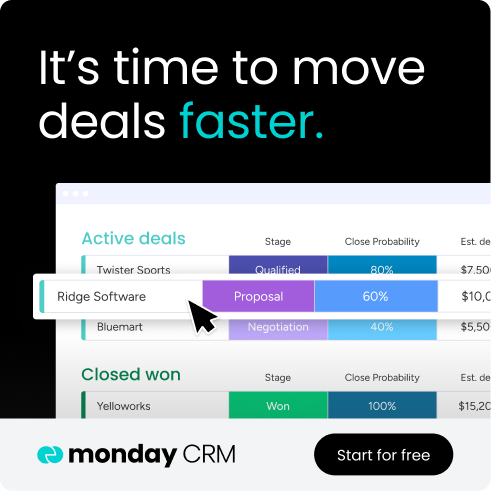A sales team’s success depends on more than just effort or personality. It requires a detailed understanding of which actions lead to closed deals and which ones waste time. Without this visibility, teams operate on guesswork, making it difficult to predict revenue, coach effectively, or scale repeatable success.
Effective sales tracking collects and analyzes that data to turn your pipeline activity into predictable revenue. This guide covers the key metrics you need to monitor, a five-step process for setting up your system, and the essential features to look for in a modern sales platform.
You will gain the confidence that comes from knowing exactly where you stand and what to do next. This process begins with a precise definition of what sales tracking is and why it forms the foundation of any high-performing sales organization.
Try monday CRMKey takeaways
- Sales tracking is your team’s GPS system that eliminates guesswork by monitoring every interaction, deal, and outcome to make data-driven decisions about your sales strategy.
- A complete sales tracking system combines pipeline stages, conversion rates, key metrics, and lead scoring to give you full visibility into what’s working and what needs improvement.
- monday CRM centralizes all customer data in one place with AI-powered automations that handle routine tasks, so your team spends time selling instead of doing data entry.
- Focus on essential metrics like pipeline velocity, stage conversion rates, win rates, and forecast accuracy to understand both where you’ve been and where you’re heading.
- While spreadsheets work for very small teams, dedicated sales tracking software scale naturally as you grow and provide the automation and collaboration features that turn tracking from a chore into a competitive advantage.
What is sales tracking and why does it matter?
Sales tracking is the process of collecting, analyzing, and reporting on sales data to understand performance and identify trends. It’s a critical business function, with the global market for the CRM platforms that enable it projected to grow to $145.79 billion by 2029.
This means monitoring every interaction, deal, and outcome to make informed decisions about your sales strategy.
Defining a sales tracking system
A sales tracking system is the combination of processes, platforms, and metrics you use to monitor sales activities. It’s your way of understanding what’s happening in your sales pipeline.
Here’s what makes up a sales tracking system:
- Pipeline: The stages your deals move through from first contact to closed sale
- Conversion rates: The percentage of prospects that move from one stage to the next
- Sales metrics: The numbers that tell you how well you’re doing
- Lead scoring: A way to rank prospects based on how likely they are to buy
Your tracking system works through three main functions. First, it collects data from every customer touchpoint. Then it analyzes that information to find patterns and insights. Finally, it reports findings in a way that helps you make decisions.
How tracking sales improves your team’s performance
When you track sales properly, you eliminate guesswork. You know exactly which activities lead to closed deals and which ones waste time. Your team can focus on what works instead of hoping for the best, which is critical since research shows employees who understand how their success is measured are twice as likely to feel motivated.
monday CRM makes this process seamless by centralizing all your customer data in one place. The platform automatically captures interactions and updates deal progress, so your team spends time selling instead of data entry.
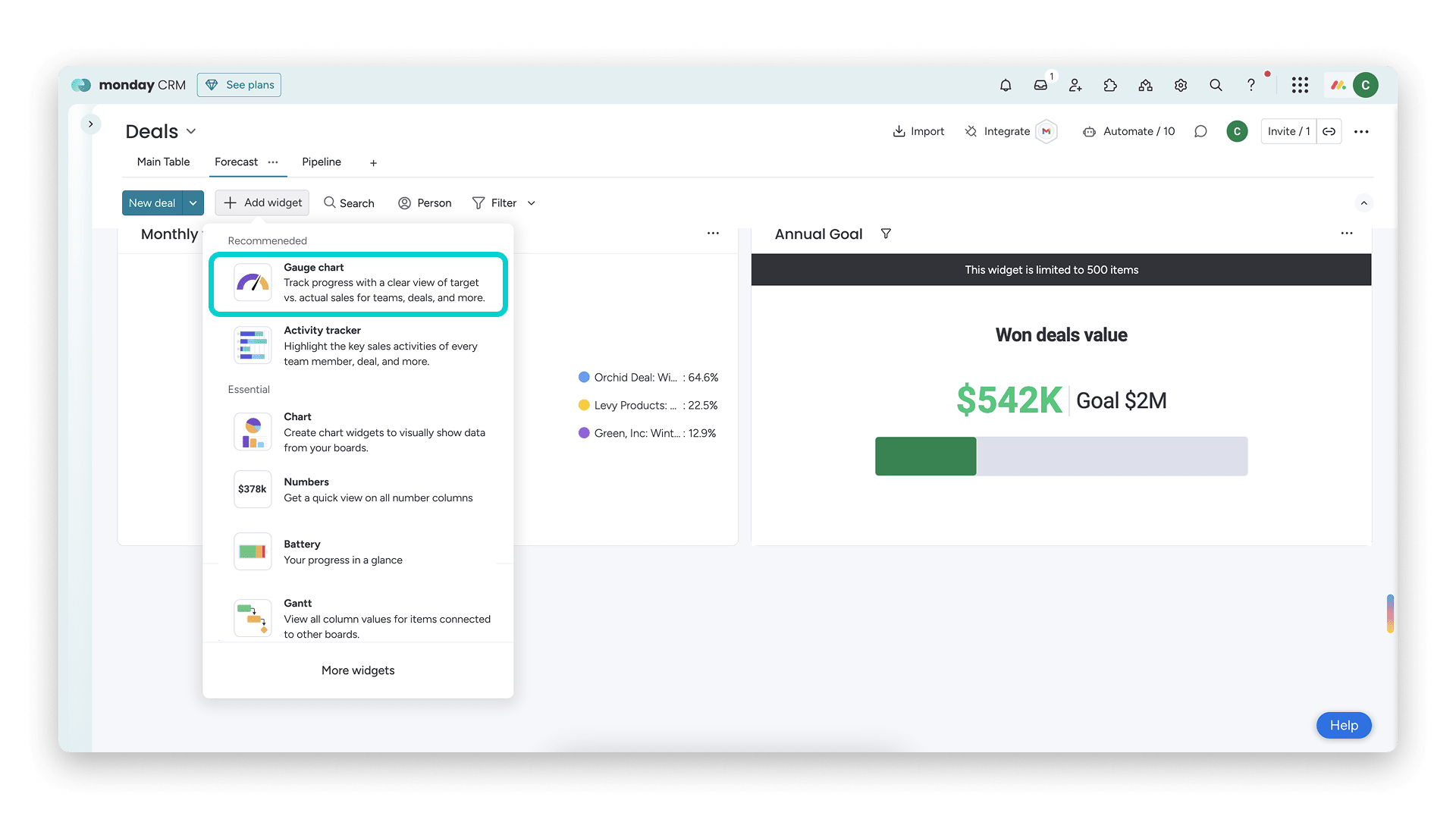
Key metrics and KPIs for sales performance.
Not all sales metrics are created equal. Some tell you what happened yesterday, while others predict what will happen tomorrow.
Leading indicators are your early warning system. They show you what’s coming. Lagging indicators are your report card, they show you how you did.
Monitoring pipeline health and conversions
Your sales pipeline is like a funnel. Deals enter at the top and (hopefully) exit as closed sales at the bottom. It’s important to be aware of where are they getting stuck.
Pipeline metrics reveal the health of your sales process:
- Pipeline velocity: How fast deals move through your stages
- Stage conversion rates: What percentage of deals advance at each step
- Average deal size: How much your typical closed deal is worth
- Win rate: The percentage of opportunities you actually close
These metrics work together to paint a complete picture. If your velocity is slow but your win rate is high, you might need to speed up your process. If velocity is fast but win rate is low, you might be rushing deals.
Ensuring forecast accuracy with a sales tracker
Can you predict next quarter’s revenue with confidence? Without proper tracking, forecasting becomes wishful thinking.
Accurate forecasting starts with weighted pipeline value. This multiplies each deal’s value by its probability of closing based on its current stage. A $10,000 deal in the proposal stage might have a 50% probability, making it worth $5,000 in your forecast.
monday CRM’s AI capabilities take forecasting further by analyzing your historical patterns. The platform’s machine learning algorithms examine past win rates, sales cycles, and seasonal fluctuations to identify hidden trends in your data.
It automatically adjusts probability scores based on deal characteristics, flags opportunities that match patterns of previously won deals, and provides real-time forecast adjustments when market conditions change.
This intelligent system learns continuously from your team’s performance, making each prediction more accurate than the last and delivering forecasts that consistently outperform even the most detailed manual calculations.
Try monday CRM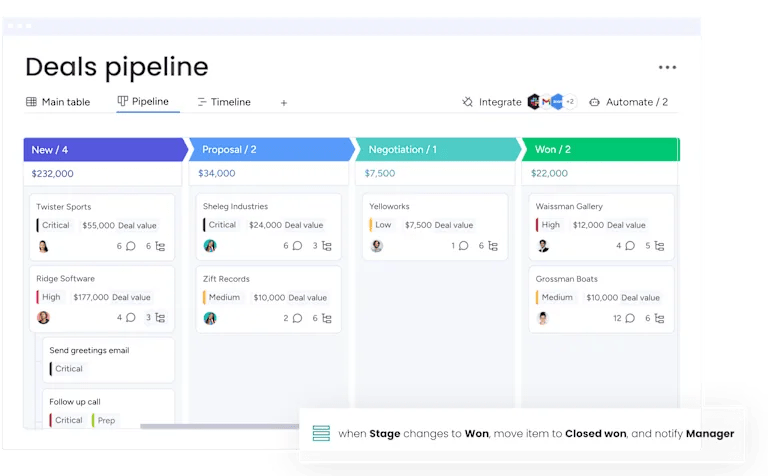
How to track sales in 5 practical steps.
Building an effective sales tracking system doesn’t happen overnight. But with these five steps, you can create a foundation that grows with your business.
Step 1: Define your sales process
Your sales process is unique to your business. Map out how deals actually move through your organization.
Start by documenting each stage from first contact to closed deal. What specific actions happen at each step? What criteria must be met to advance? How long does each stage typically take?
monday CRM lets you create custom pipeline stages that match your exact process. This flexibility means your tracking system reflects reality, not some generic ideal.
Step 2: Choose an online sales tracker or CRM
The platform you choose will shape how your team works every day. Make this decision carefully.
Consider these essential features when evaluating options:
- Data centralization: All customer information in one place
- Automation capabilities: Less manual work for your team
- Reporting functions: Insights without technical expertise
- Integration options: Connections to your other business systems
Small teams might start with spreadsheets, but most quickly outgrow them. A platform like monday CRM provides professional capabilities while remaining intuitive enough for non-technical users.
Step 3: Set up automations and AI capabilities
Why waste time on repetitive tasks when technology can handle them? Modern sales tracking platforms automate the boring stuff so you can focus on selling, yet research shows that only 51% of sales professionals are currently using AI, leaving a significant opportunity for efficiency gains.
Set up automations for common scenarios. When a deal reaches a certain stage, automatically notify the account manager. When a prospect opens your proposal three times, alert the sales rep to follow up.
monday CRM’s AI Blocks add intelligence to your automations. They can categorize leads, extract information from documents, and even suggest the best next action for each deal.
Step 4: Measure results with sales tracking platforms
Data without action is just numbers on a screen. Your tracking platform should drive specific behaviors and decisions.
Create dashboards for different audiences. Sales reps need to see their individual performance and upcoming activities. Managers need team overviews and pipeline health. Executives need revenue forecasts and trend analysis.
Schedule regular reviews to act on your data. Daily huddles might cover activity metrics. Weekly meetings can review pipeline movement. Monthly sessions should analyze trends and adjust strategies.
Step 5: Share insights and encourage collaboration
Sales doesn’t happen in a vacuum, and research shows that organizations with aligned departments can achieve up to 38% higher sales win rates. Your tracking system should connect teams, not isolate them.
monday CRM’s collaboration features make sharing natural. Team members can comment on deals, tag colleagues for input, and see real-time updates without switching between systems.
Top features to look for in a sales tracking program.
The right features can transform your sales tracking from a chore into a competitive advantage. Here’s what to prioritize.
Data integration and centralization
Scattered data creates scattered results. Your sales tracking platform should be the single source of truth for all customer information.
Integration capabilities determine how well your platform plays with others:
- Email integration: Automatically log all customer communications
- Calendar sync: See meetings and activities in context
- Marketing platform connections: Track lead sources and campaign effectiveness
- Accounting system links: Connect sales data to financial outcomes
monday CRM connects with the platforms you already use. This means less manual data entry and more complete customer profiles without extra effort.
AI-driven automations and notifications.
AI isn’t just buzzword — it’s a practical way to work smarter. The right AI features act like an assistant that never sleeps.
Look for AI that handles specific sales tasks. Lead scoring that actually predicts purchase likelihood. Sentiment analysis that flags when a deal might be going south. Sales forecasting software that can help with the next-best-action suggestions based on what’s worked before.
monday CRM’s AI capabilities go beyond basic automation. The platform can extract key information from uploaded documents, categorize leads based on multiple factors, and even help draft personalized follow-up emails.
Custom reports and visual dashboards
Numbers in rows and columns don’t inspire action. Visual dashboards that tell a story do.
Your reporting system should adapt to different needs. A sales rep might want a simple view of their deals and activities. A manager needs to compare team performance and spot coaching opportunities. An executive wants to see revenue trends and forecast accuracy.
The best platforms make report creation simple. Drag and drop the metrics you care about. Choose visualizations that make sense for your data. Set up automated distribution so insights reach the right people at the right time.
Try monday CRM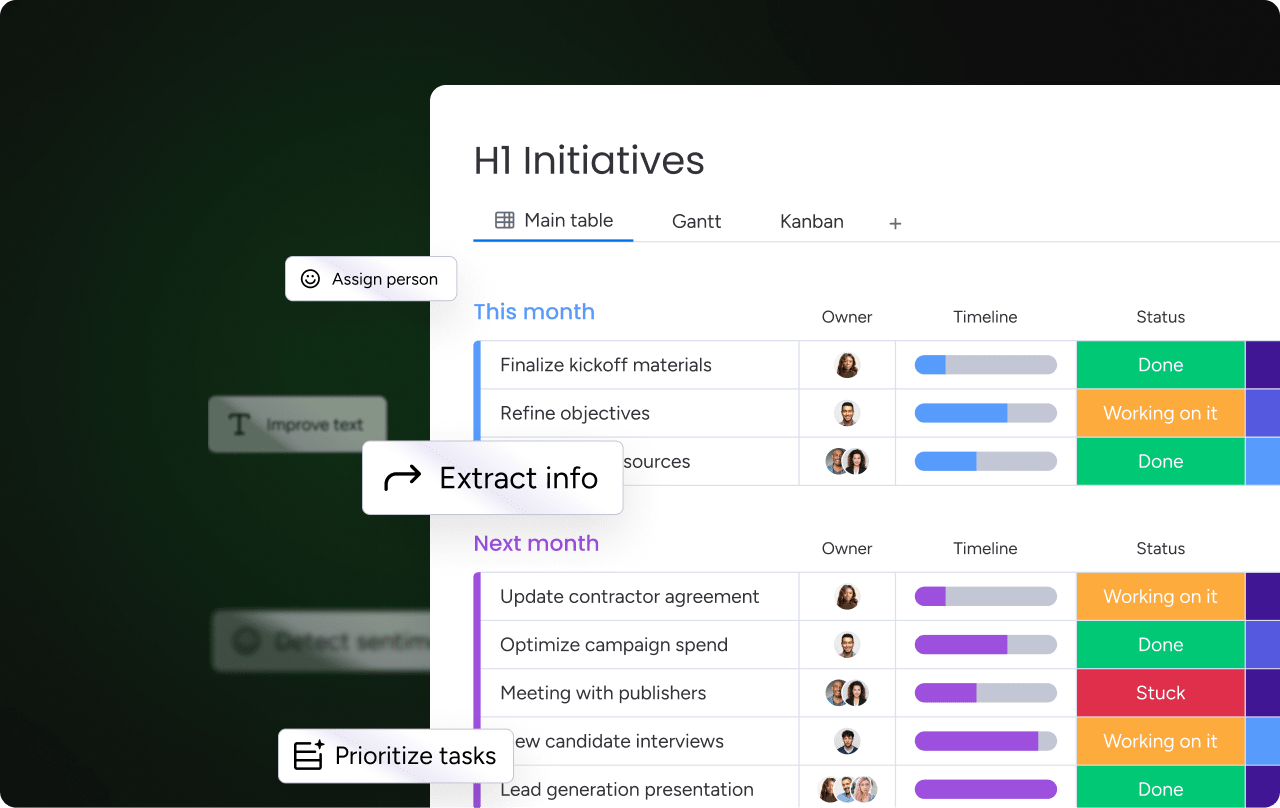
Comparing spreadsheets versus dedicated sales tracking platforms.
Many teams start tracking sales in spreadsheets as it’s familiar. With time, most eventually switch to dedicated platforms, and here’s why:
Pros and cons of spreadsheet sales tracking.
Spreadsheets have their place in sales tracking, especially for very small teams or simple processes.
The advantages are real. There’s no software cost. Most people already know the basics. You have complete control over layout and calculations.
But limitations appear quickly as you grow:
- Manual everything: Every update requires human input
- Version chaos: Multiple copies lead to conflicting data
- No automation: Repetitive tasks stay repetitive
- Limited collaboration: Hard to work together in real-time
- Security concerns: Sensitive data sits unprotected
| Feature | Spreadsheets | Dedicated platform (like monday CRM) |
|---|---|---|
| Initial cost | Free | Subscription-based |
| Learning curve | Low | Moderate |
| Automation | None | Extentsive |
| Real-time collaboration | Limited | Built-in |
| Date accuracy | Depends on manual input | Automated validation |
| Scalability | Hits limits quickly | Grows with you |
Why a dedicated sales tracking platform offers more scalability.
When your two-person sales team becomes twenty, or when your simple process evolves into a sophisticated sales machine, spreadsheets become to complex and break down. Formulas become fragile. Data entry becomes overwhelming. Collaboration becomes impossible.
monday CRM allows you to scale naturally. Add new team members without rebuilding your system. Create new pipeline stages without breaking existing reports. Integrate new platforms without manual data transfer.
Its real advantage is time. Every hour your team spends managing spreadsheets is an hour not spent selling.
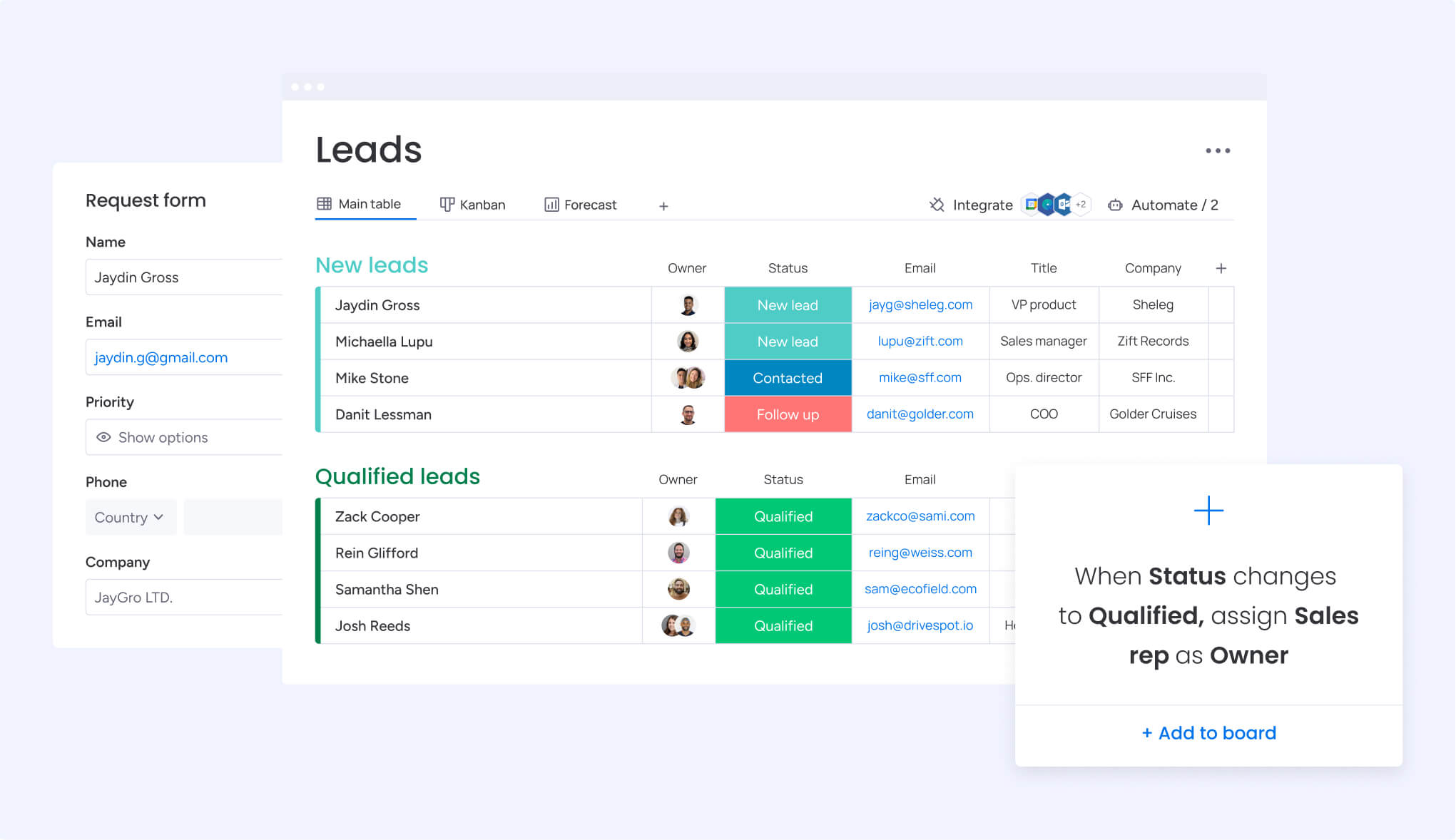
Small business sales tracking essentials.
Small businesses face a unique challenge. You need professional sales tracking but can’t afford enterprise complexity or cost.
How to keep track of sales with limited resources
Start simple. Track only what directly impacts your business success.
Focus on these essential metrics first:
- Lead sources: Where your best customers come from
- Conversion rates: How many prospects become customers
- Sales cycle length: How long deals take to close
- Average deal value: What each customer is worth
Build habits before systems. Even the best platform won’t help if your team doesn’t use it consistently. Start with daily data entry routines and weekly review meetings.
monday CRM’s intuitive design helps here. The platform feels familiar from day one, so your team can focus on selling instead of learning complicated software.
Free sales tracking software and trials
Before committing to any platform, test it with your real sales process. Most platforms offer free trials .
During your trial, focus on daily usability. Ask yourselves these questions:
- Can your team learn it quickly?
- Does it integrate with your existing platforms?
- How responsive is customer support when you need help?
Test with actual data, not demo information. Import a subset of your real contacts and deals. Run through your typical sales scenarios. Generate the reports you’ll actually use.
Transitioning from spreadsheet to a sales tracking CRM
If you want to progress from spreadsheets, plan your transition carefully to avoid disrupting active deals. Make sure you:
- Clean your existing data: Remove duplicates, standardize formats, and update outdated information—remember that bad data in means bad data out.
- Map your spreadsheet fields to CRM fields: Not everything needs to transfer immediately — prioritize active deals and recent contacts first, leaving historical data for later.
- Train your team before the switch: Leverage monday CRM’s transition resources to help your team adapt smoothly, starting with basic features and gradually introducing more advanced functionality as comfort levels increase.

Speed up growth with monday CRM.
Consider what could your sales team accomplish with complete visibility into every deal, automated routine tasks, and AI-powered insights.
The right sales tracking system doesn’t just measure what happened, it helps you shape what happens next. When every team member knows exactly where to focus their efforts, results follow naturally.
monday CRM adapts to your unique sales process instead of forcing you into a rigid framework. Start with basic tracking and add sophisticated features with time. The platform’s flexibility means you’re never locked into one way of working.
Try monday CRM and discover what your team can achieve with the right platform behind them.
Try monday CRMFrequently asked questions
What is the best sales tracking method for small businesses?
The best sales tracking method for small businesses combines simple metrics with an affordable CRM platform that can grow with your company as needs evolve.
How do I track sales performance in Excel?
To track sales performance in Excel, create columns for contact information, deal stages, values, and close dates, then use formulas to calculate conversion rates and pipeline totals.
What sales metrics should a startup track?
Startups should track lead sources, conversion rates between pipeline stages, average deal size, sales cycle length, and customer acquisition cost to understand sales efficiency.
How often should I review sales tracking data?
Review sales tracking data daily for individual activities, weekly for pipeline movement and team performance, and monthly for trends and strategic adjustments.
What's the difference between a CRM and sales tracking software?
A CRM is a comprehensive platform that manages all customer relationships and interactions, while sales tracking software specifically focuses on monitoring sales metrics and pipeline progress.
How do I track sales team performance effectively?
Track sales team performance effectively by monitoring both activity metrics (calls, emails, meetings) and outcome metrics (deals closed, revenue generated) while providing regular coaching based on the data.
